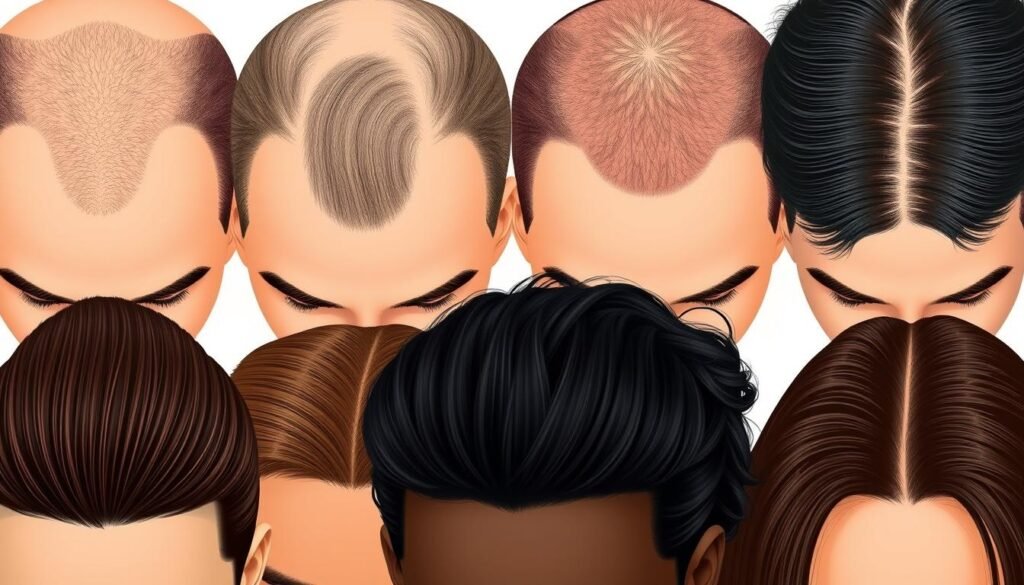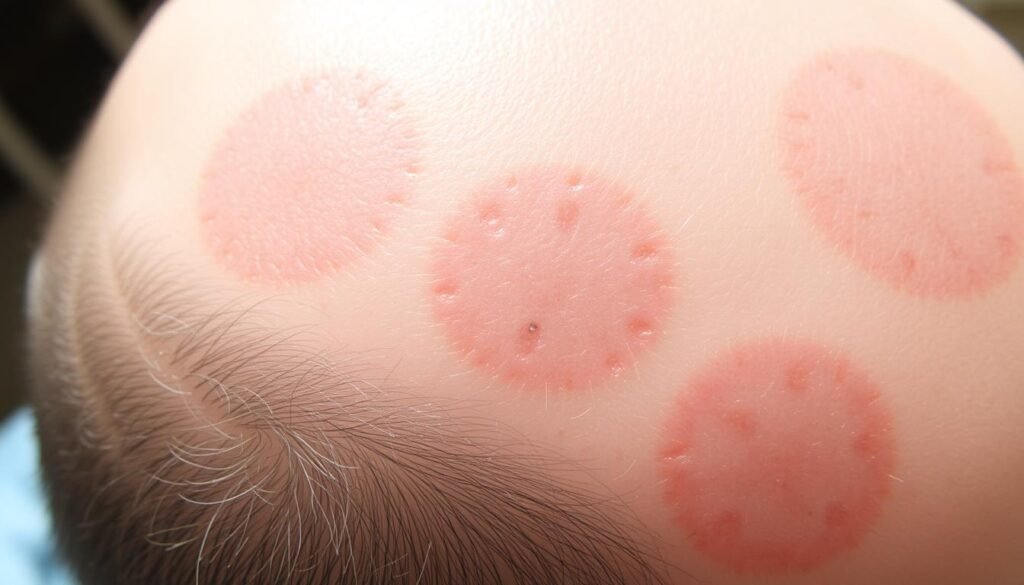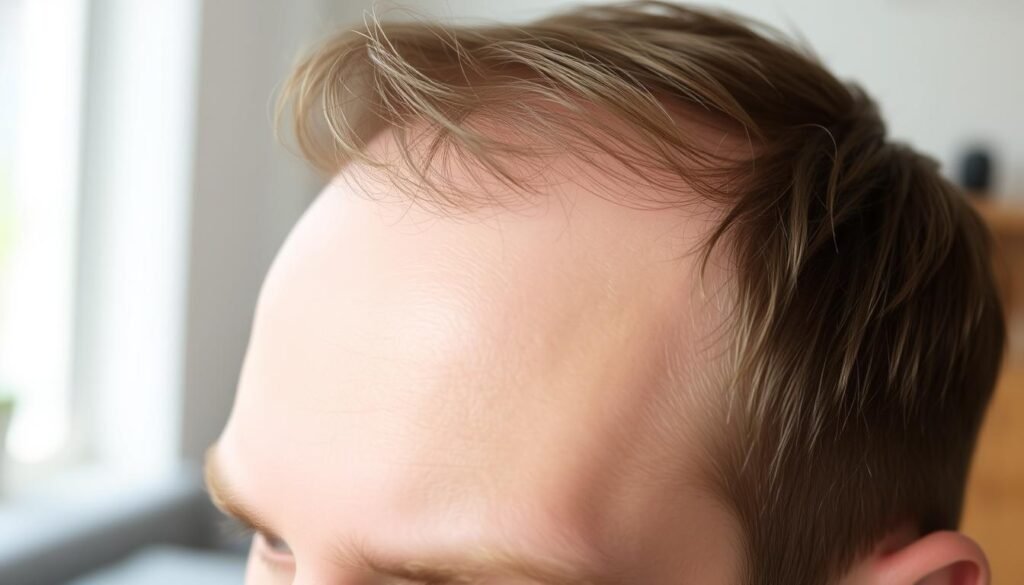Approximately 6.8 million people in the United States have alopecia. It’s key to recognize the early signs of alopecia because early action can really help. Alopecia shows itself in different ways, with early signs like patchy bald spots or thinner hair. So, keeping an eye on hair health is very important.
Knowing about hair loss and how it develops helps in catching it early. People can then act quickly to slow down hair thinning. Recognizing these signs early means you can seek help and possibly get your hair back. For symptoms of alopecia, check out more here.
Key Takeaways
- Alopecia affects millions in the U.S., highlighting the need for early recognition.
- Subtle early signs of hair loss are essential for prompt intervention.
- Recognizing the early signs of alopecia can improve treatment outcomes.
- Understanding different types of hair loss helps identify symptoms more effectively.
- Timely action can significantly restore confidence in affected individuals.
Understanding Alopecia and Its Types
Alopecia includes different conditions of hair loss. Knowing about alopecia helps in finding the right treatment. The most common types are:
- Alopecia Areata: This hair loss occurs suddenly, leaving round bald patches. It’s often due to the immune system attacking hair follicles by mistake.
- Androgenetic Alopecia: Known as pattern baldness in men and women, it’s usually inherited. It appears slowly and relates to hormonal shifts.
- Telogen Effluvium: This happens when hair stops growing too early, causing more hair to fall out. It can be triggered by stress, sickness, or hormonal changes.
Understanding alopecia types helps people figure out their hair loss. Not every hair loss is for good. Many kinds can get better with the right help. Getting advice from doctors leads to a plan that works best, helping hair come back.
Clinical studies and articles on skin health show why knowing about alopecia is key. Each type has its own signs, ways to help, and outlook. By learning these details, people can join in on fixing their hair loss issue.
| Type of Alopecia | Characteristics | Associated Factors |
|---|---|---|
| Alopecia Areata | Sudden hair loss in patches | Autoimmune disorders |
| Androgenetic Alopecia | Gradual thinning or baldness | Genetic predisposition |
| Telogen Effluvium | Increased shedding; may be temporary | Stress, illness, hormonal changes |
Recognizing the Early Signs of Alopecia
Finding early signs of alopecia early is key to managing it well. People often miss little changes in their hair. These changes might be the first clue to a bigger problem. Spotting common hair loss signs early can help start treatments sooner, changing how hair thinning progresses.
Common Symptoms to Notice
People with early alopecia might see several symptoms, such as:
- Thinning hair, particularly at the crown or along the hairline.
- Increased hair shedding, especially during washing or brushing.
- Development of bald spots, which may appear suddenly and vary in size.
These symptoms are warnings to look out for, pointing to the need for a doctor’s visit or treatment. It’s important to keep an eye on these signs. Seeing a healthcare professional when needed is crucial.
Impact of Stress on Hair Loss
Stress and hair loss go hand in hand, as stress affects hair growth cycles. When stressed, many hair follicles may enter the shedding phase too soon. This condition, telogen effluvium, causes noticeable hair thinning and more shedding.
Knowing how stress affects hair can help us deal with it better, possibly reducing hair loss. Spotting stress-related hair issues helps us learn how to manage stress effectively.
| Symptom | Description |
|---|---|
| Thinning Hair | A gradual reduction in hair density, often starting at the crown. |
| Increased Shedding | Excessive hair loss noticeable during grooming or daily activities. |
| Bald Spots | Sudden hair loss forming small, round patches across the scalp. |
Different Hair Loss Patterns
Knowing about different hair loss patterns is vital for men and women who are losing hair. These patterns can vary based on gender and other factors. Knowing the differences helps in finding the right treatment.
Typical Patterns in Men and Women
Men and women lose hair in unique ways. Men often deal with male-pattern baldness, or androgenetic alopecia. It starts with a receding hairline or thinning at the crown. Women, however, tend to have thinning all over, leading to less volume instead of bald spots. Both men and women hair loss need different care and solutions.
Telogen Effluvium Explained
Telogen effluvium is a hair loss type that both genders may experience. It’s marked by temporary hair shedding. This can happen due to stress, hormonal changes, or sickness. Unlike other hair loss types, telogen effluvium results in overall shedding. Knowing about it can help people understand that their hair loss might be temporary. Thus, they can find ways to deal with it effectively.

Alopecia Areata: Unique Features
Alopecia areata is a special kind of hair loss caused by the immune system. It results in sudden, patchy loss of hair. People might find small, round bald spots on their head or other body parts. This condition is hard to predict. Some see their hair grow back, only to lose it again later. This cycle can be hard to deal with emotionally.
Alopecia areata might also be linked to other health issues, like thyroid disease or vitiligo. Knowing these links is key for spotting the problem early and managing it well. By understanding alopecia areata, people can better explain their symptoms to doctors. This helps in finding the best ways to cope with the condition.
To get a better grasp of alopecia areata, see the table below. It compares alopecia areata with other types of hair loss:
| Feature | Alopecia Areata | Androgenetic Alopecia | Telogen Effluvium |
|---|---|---|---|
| Type | Autoimmune hair loss | Genetic hair loss | Stress-related hair loss |
| Hair Loss Pattern | Patchy | Thinning | Diffuse |
| Hair Regrowth | Possible spontaneous regrowth | Progressive | Varies with stress resolution |
| Associated Conditions | Other autoimmune disorders | None typically noted | Commonly associated with stress or illness |

Knowing about alopecia areata helps those going through it. Being aware of its signs and related conditions enables people to talk effectively about their treatment and care options.
Androgenetic Alopecia and Its Indicators
Androgenetic alopecia is widely known as male or female pattern baldness. It’s the most common type of hair loss affecting many people. Knowing about genetic factors is key to fighting this condition. Genetics play a big role, leading to thinning hair, sometimes starting early in life.
Genetic Factors Contributing to Hair Loss
Studies show certain genes make people more likely to get androgenetic alopecia. If hair loss is common in your family, you might be at risk. These genetic hair loss factors highlight its hereditary aspect. Those with family history might see hair thinning sooner than others.
Progression of Androgenetic Alopecia
The way hair loss unfolds differs from person to person. It often starts with hair getting thinner around the crown or temples. Over time, bald spots may become more evident. Many notice changes in hair volume and coverage over the years.
Knowing how hair loss progresses is useful for early action. Catching these signs early means more choices for treatment. These options range from creams to surgeries to slow down hair loss.

Identifying Thinning Hair
Spotting thinning hair is key for keeping hair healthy. Many times, people miss the first signs of hair thinning. These can be unusual hair loss during daily routines. Noticing texture or volume changes over time is also crucial.
To check hair density, try the two-finger test. Pinch your scalp with two fingers and pull gently to see the hair amount. Too much hair loss may be a signal of trouble. Doing regular checks helps catch identifying thinning hair early.
It’s important to keep up healthy hair habits to avoid losing more. This includes eating well to give your hair the nutrients it needs. If hair loss doesn’t stop, seeing a doctor for treatment for hair loss might be needed. Getting help early usually works better.
Below is a table with common thinning hair signs and what to do:
| Signs of Hair Thinning | Suggested Actions |
|---|---|
| Increased hair shedding | Monitor hair loss patterns and consult with a specialist |
| Visible scalp | Consider topical treatments or therapies |
| Changes in hair texture | Review hair care products for suitability |
| Thinner ponytail | Assess stress levels and potential nutritional deficiencies |
Bald Spots: What to Look For
Bald spots often show up without warning. They are a clear sign of possible hair loss issues. Noticing these signs early can help you act fast to maybe get your hair back and stop more loss. It’s important to understand the size, shape, and how quickly these bald spots appear. This can help you take action in time.
Size and Shape of Bald Spots
Bald spots can be small or cover large areas of the scalp. They might look round or oval. Noticing any quick changes in how thick your hair is can give hints about what’s causing it. You should watch out for:
- Small round patches on the scalp.
- Shapes that might grow bigger as time goes on.
- The way hair feels around the spot might change too.
When to Seek Professional Help
It’s really important to talk to a doctor when you see bald spots starting. You should ask for help if you notice:
- Bald spots that show up fast and grow quickly.
- If there’s itching or redness around the spots.
- Or if your hair’s texture or growth changes and stays that way.
Finding these signs early can make treatments work better. Knowing when to look for help is a big step in dealing with hair loss.
Scalp Inflammation and Its Effects
Scalp inflammation is a big factor in hair loss. It really hurts the health of hair follicles. Problems like psoriasis and dermatitis can cause hair to fall out because of inflammation. This bad environment slows down hair growth. It makes it hard for people to keep their hair thick.
Scalp health is not just about hair looks; it affects your overall health too. Keeping your scalp healthy stops inflammation and hair loss. A good cleaning routine and the right skincare help a lot. They keep the scalp healthy, which means better blood flow and stronger hair follicles. If you’re having scalp problems, it’s a good idea to see a dermatologist. They can give advice that fits your needs.
To fight hair loss, it’s important to deal with inflammation. Inflammation and hair loss are linked, so taking care of your scalp matters a lot. By doing so, you help your hair grow in a healthier way. For those who want to learn more, check out this study on alopecia areata. Knowing more about this can help people find good treatments for better hair health.